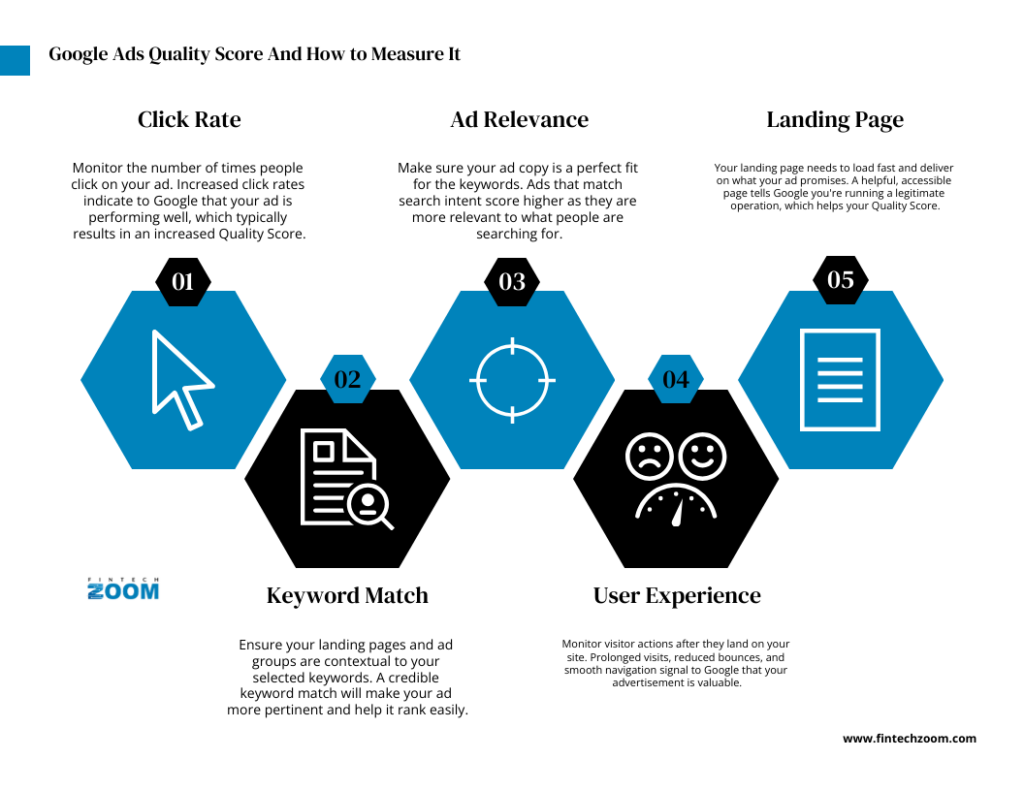Burning cash faster than your morning coffee rush? Google Ads may be your cash drain or your cash cow, and the trick is in one frequently disregarded measure, Quality Score.
This small figure defines the level of relevancy, genuineness, and cost-effectiveness of your campaigns. Nail it and you will find lower costs, higher click-through rates, and much better ROAS. You miss it and continue to pay higher than you should to get mediocre results.
Google Ads Quality Score And How to Measure It
The Google Ads Quality Score is the score that Google gives to the relevance of your ads, landing pages, and keywords. It determines the performance of your advertisements and the cost.
In order to gauge it successfully, you must consider some main factors that indicate how your ads resonate with users and the Google system. An expert Google Ads agency like MagnifyLab can help in achieving a higher Quality Score without much hassle.
Click Rate
Monitor the number of times people are actually clicking on your ad. Increased click rates simply indicate to Google that your advertisement is performing its work and that typically results in increased Quality Score.
Ad Relevance
Make sure that your advertisement copy is a perfect fit for the keywords. Advertisements that match the search intent score more points as they are related to what people are searching for.

Landing Page
Your landing page needs to load fast and deliver on what your ad promises. A helpful, accessible page not only keeps potential customers happy, it tells Google you’re running a legit operation, which can only help your Quality Score.
Keyword Match
Make sure that your landing pages and ad groups are contextual to the keywords that you select. A credible match of keywords will allow your ad to be more pertinent and easily rank.
User Experience
Monitor the visitor actions after landing on your site. Prolonged visits, reduced bounces and a smooth navigation signal to Google that your advertisement is actually valuable.
How Low Quality Scores Hurt Your ROAS
Higher Costs
When scores are low, Google charges more per click. This implies that you will have to pay an additional amount of money in order to keep your advertisements on view, reducing your ratio of ad spend.
Poor Ranking
Your ads will be less frequent or lower in position with low Quality Scores. This minimises visibility and it becomes difficult to access the appropriate audience.
Lower Clicks
When you do not match your ads with what people search, most users do not click on them. A reduced number of clicks results in reduced traffic and will reduce your likelihood of achieving meaningful conversions.
Weak Relevance
Google punishes irrelevant ads. A low score indicates that Google thinks your ad is not relevant enough, and so it will not appear to users who are more likely to convert.
Reduced ROI
When the cost increases and performance declines, your investment payback is hurt. The Low Quality Scores present a chain of events where advertisements are required to be more expensive yet less effective in bringing meaningful outcomes. In fact, UK ad spend rose 8% in Q1 2025, showing how rising competition is driving costs higher.
Key Strategies to Improve Quality Score
Keyword Research
Select the appropriate keywords that meet user intent. Specific long-tail and negative keywords mean that your advertisements will reach the appropriate people and be more successful in general.
Ad Copy
Compose advertisement content that directly relates to the keywords and the searches made by the users. Powerful and clear headlines and strong CTAs enhance the interaction and raise your Quality Score to a high level.
Landing Speed
Ensure that your opening pages do not load slowly. A fast page will reduce bounces, improve the experience, and directly influence the increase in the Quality Score.
Mobile Friendly
Make sure that your landing pages are mobile-friendly. Advertisements will be more compelling and more appropriate when they are mobile-friendly because most users will be browsing on phones.
Ad Groups
Make your advertisement groups lean and mean. Categorise related keywords together so that your advertisements are really relevant. When Google takes notice, and your Quality Score is up. It is one of those things that do not appear much, but is a big deal.
A/B Testing
Test ad headings, descriptions and CTAs to see which ones perform best. The continuous testing will also increase the number of click-throughs, which will yield improved Quality Scores in the long run.
Ad Extensions
Use callouts, sitelinks, and structured snippets to give additional information. One of the benefits of extensions is that they enhance the visibility of the ad, invite clicks, and send signals to Google that your ad offers more value.
Negative Keywords
Make sure you add negative keywords, this will help you to avoid appearing in unrelated search results. This will allow a decrease in the number of useless clicks, increasing target audience relevancy and strengthening Quality Score.
User Experience
Create interesting landing pages that are easy to read and easy to navigate. Excellent user experience results in increased visits, conversions and a message to Google that your advertisements are not harmful.
Conclusion
Increasing your Quality Score will imply smarter advertisements, reduced cost, and improved performance. Think about making your ads relevant, experiment with them, and consider the user experience so clicks translate into meaningful conversions and thereby maximise your ROAS.

